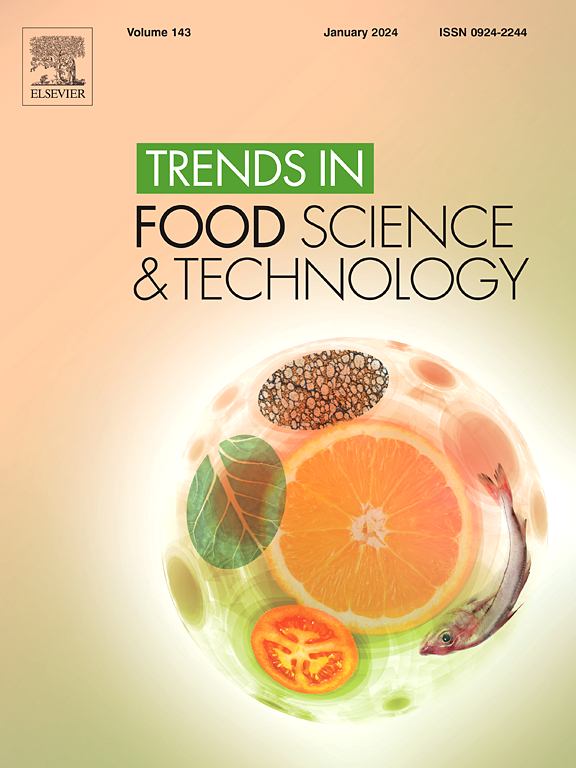推进可持续食品包装:整合机器学习、深度学习和人工智能
IF 15.1
1区 农林科学
Q1 FOOD SCIENCE & TECHNOLOGY
引用次数: 0
摘要
人工智能(AI)在食品包装中的应用正在以突破性的技术改变食品行业,以提高食品安全、质量和可持续性。越来越多的人工智能技术,包括机器学习(ML)和深度学习(DL),正在被整合到包装策略中。本文对智能、主动和智能包装系统的发展进行了深入的概述,重点是基于人工智能的技术,如机器学习(ML)和深度学习(DL)。此外,新的智能技术,如高光谱成像(HSI)和机器人技术进行了讨论,以确定其在优化包装过程中的应用。人工智能在食品包装中的各种应用,包括保质期预测、质量评估和缺陷检测,都进行了彻底的研究。此外,还有一些挑战,包括数据异构、模型功能和可扩展性,这些都突出了对成功部署的强大AI框架的需求。总体而言,食品包装行业有能力利用人工智能来提高生产率,改善食品安全,并最大限度地减少食品浪费。主要发现和结论人工智能在食品包装中的应用带来了显著的好处,包括提高生产率、改善食品安全和减少浪费。解决数据和模型性能问题是充分利用这些技术的必要条件。开发完全自动化的检测解决方案和实时监控系统应该是未来研究的重中之重,以显著提高食品包装的可持续性和真实性。本文章由计算机程序翻译,如有差异,请以英文原文为准。

Advancing sustainable food Packaging: Integrating machine learning, deep learning, and artificial intelligence
Background
The implementation of artificial intelligence (AI) in food packaging is transforming the food industry with groundbreaking technologies to improve food safety, quality, and sustainability. A growing assortment of AI technologies, including machine learning (ML) and deep learning (DL), are being integrated into packaging strategies.
Scope and approach
This paper provides an in-depth overview of the development in smart, active, and intelligent packaging systems, with a focus on AI-based technologies such as machine learning (ML) and deep learning (DL). Further, new smart technologies like hyperspectral imaging (HSI) and robotics are discussed to identify their applications in optimizing packaging processes. The various applications of AI in food packaging, including shelf-life prediction, quality assessment, and defect detection, are thoroughly examined. In addition, there are challenges, including data heterogeneity, model capabilities, and scalability, that highlight the need for a robust AI framework for successful deployment. Overall, the food packaging sector has the ability to leverage AI to increase productivity, improve food safety, and minimize food wastage.
Key findings and conclusions
The application of AI in food packaging offers significant benefits, including increased productivity, improved food safety, and reduced waste. Resolving data and model performance difficulties is necessary to fully leverage these technologies. The development of completely automated inspection solutions and real-time monitoring systems should be the top priorities of future research to enhance the sustainability and authenticity of food packaging significantly.
求助全文
通过发布文献求助,成功后即可免费获取论文全文。
去求助
来源期刊

Trends in Food Science & Technology
工程技术-食品科技
CiteScore
32.50
自引率
2.60%
发文量
322
审稿时长
37 days
期刊介绍:
Trends in Food Science & Technology is a prestigious international journal that specializes in peer-reviewed articles covering the latest advancements in technology, food science, and human nutrition. It serves as a bridge between specialized primary journals and general trade magazines, providing readable and scientifically rigorous reviews and commentaries on current research developments and their potential applications in the food industry.
Unlike traditional journals, Trends in Food Science & Technology does not publish original research papers. Instead, it focuses on critical and comprehensive reviews to offer valuable insights for professionals in the field. By bringing together cutting-edge research and industry applications, this journal plays a vital role in disseminating knowledge and facilitating advancements in the food science and technology sector.
 求助内容:
求助内容: 应助结果提醒方式:
应助结果提醒方式:


